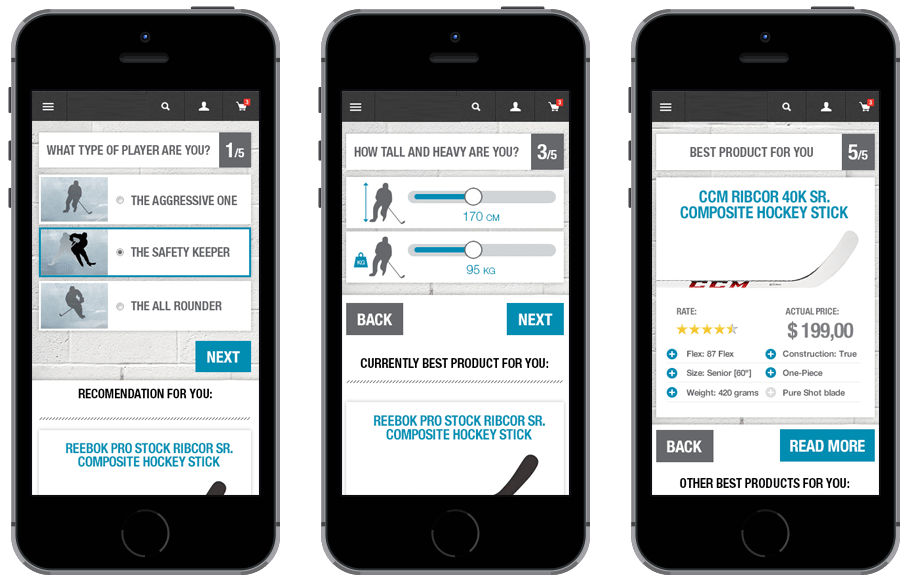Today, most purchase decisions are reached on the Internet. Whenever shoppers have a need or want, the majority hops on the Internet first, to look for useful information and advice on products that meet their requirements. Considering the vast amount of offers and products available, it gets harder for shoppers to make confident purchase decisions. A more sophisticated approach is needed to navigate your shopper’s online shopping experience.
Looking at the new consumer-decision journey (McKinsey), the active evaluation phase in a shopper’s decision journey is the most critical phase. It is the phase in which shoppers research potential options, add new brands or products to the considered set and throw out others. It is also where they are most receptive to decision-support like product information, product reviews, and individual recommendations.

In order to have any influence on your shoppers purchase decisions, you need to actively provide information that is relevant to them and helps them as they make a purchase-decision. If you don’t, somebody else will.
Rather than pushing (unrelated) products to your shoppers, focus on making information available that they can control and pull whenever they want. Guiding your shoppers through the buying process will result in a committed purchase on their part, leading to increased sales for you. The type of buying assistance consumers seek varies greatly based on their comfort with navigating the product consideration process. Guided selling provides a dynamic user experience that can be easily navigated by consumers with all levels of expertise.
Kevin Howarth CEO & Founding Principal, User Interface Engineering, Jared Spool
Guided Selling becomes more important as the buying experience on the web and on mobile devices continues to evolve – from features to experience.
What is Guided Selling?
Guided selling is like an experienced sales rep you might find at a brick and mortar store. It simulates a conversation and asks questions to understand a shopper’s needs, their personality, experience, specific situation, expectations and intended usage. By asking need-oriented questions, the shopper is able to articulate and express their requirements in non-technical terms.
The solution translates the complex input, such as “I need a cool laptop computer”, into a technical specification and determines options that suit his or her needs.
Guided selling is more complex than a series of feature-based filters as it also ranks products by their suitability, provides reasons for each recommendations, and enables enhanced and more personalized shopping experiences.

Benefits of Guided Selling
If done well, Guided selling empowers your shoppers, increases conversion rates and accelerates the purchase decision process.
For Businesses
- Additional Sales Conversions
- Deeper product discovery, by providing compelling and relevant product recommendations to customers
- Collecting real-time shopper insights
- Reducing the cost of acquisition of customers
- Avoiding loss of sales due to out-of-stock inventory, by suggesting the next-best available product
- Cross sell and upsell effectively
- Raise the value of relationships through intelligent selling complimentary products, upgrades, and higher-value alternatives
For Shoppers
- Fulfilling shoppers’ desire for an utterly unique product or experience
- Providing shoppers with complete knowledge of the available options
- Giving shoppers a sense of immediacy with the help of images, specifications, and summaries
- As a customer chooses one option, after another, their sense of investment in the product increases, along with the probability that they will purchase something that is suitable to their individual needs
How does Guided Selling work?
There are two approaches to setting up a Guided Selling solution:
1. Static solutions:
These hard-coded solutions, implement a decision-tree by mapping each answer to certain products. It may be set up quickly, however, it has a disadvantage that it is not scalable and not easy to maintain.
2. Dynamic solutions:
These solutions found on a sophisticated knowledge and rule set in which answers are connected to product features e.g., if the answer is “Light laptop” the associated rule might be “weight less than 2 kg”. These solutions are more flexible and much easier to maintain once new products are added to the assortment.
What to look for in a Guided Selling Software
Look for a technology that supports you and how you sell. It should be integrated into your general workflow, and smart enough to aid the selling process while giving you the data you need to improve your marketing and sales process. It may be even better for you not to choose any solution at all than integrating a solution that is not up to par and has more potential to do harm than good. If you are interested in a guided selling software, here are some considerations.
- Ease of use: The flexibility to handle your products, pricing and sales process.
- Compatibility: The ability of the software to integrate with your multiple touchpoints
- Relevance: A level of intuitiveness that will incorporate elements of machine learning
- Content management: Look at the types of content the system supports (not just PDFs).
- Analytics and reporting: A system management environment that will enable you to ensure performance, availability and useful information.
The whole point of Guided Selling is to provide customers with the same level of advice online that they would get from a salesperson in a store, even more so with recommendations being made by their peers.
Guided Selling not only benefits the customer, but it increases your online conversions and sales. Be sure to choose the right system for your specific customer needs.
How would Guided Selling improve your customer experience? Sound off in the comments below.


